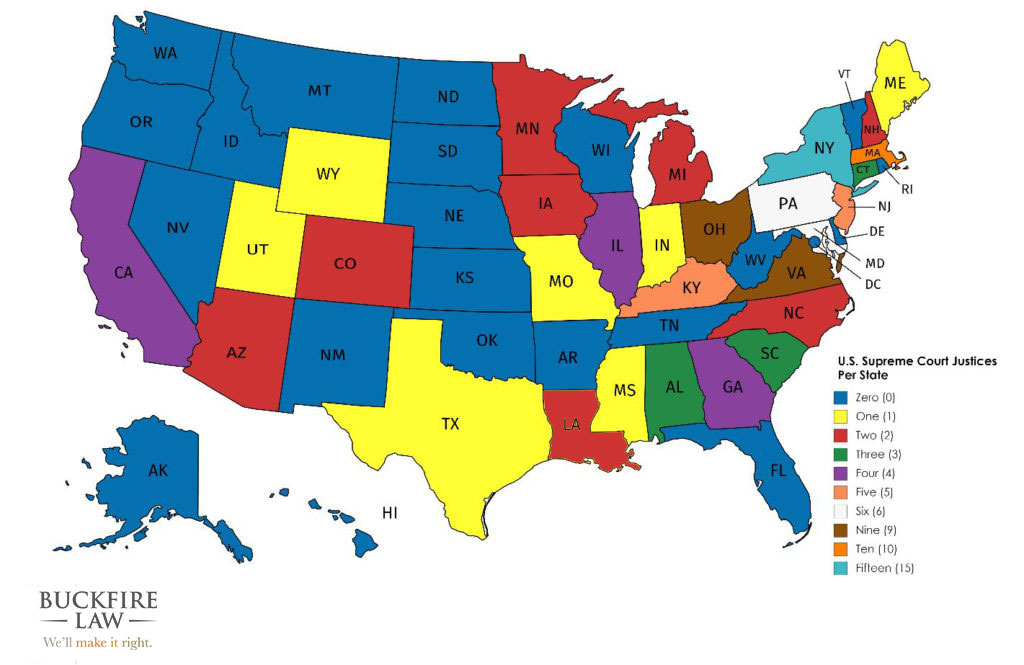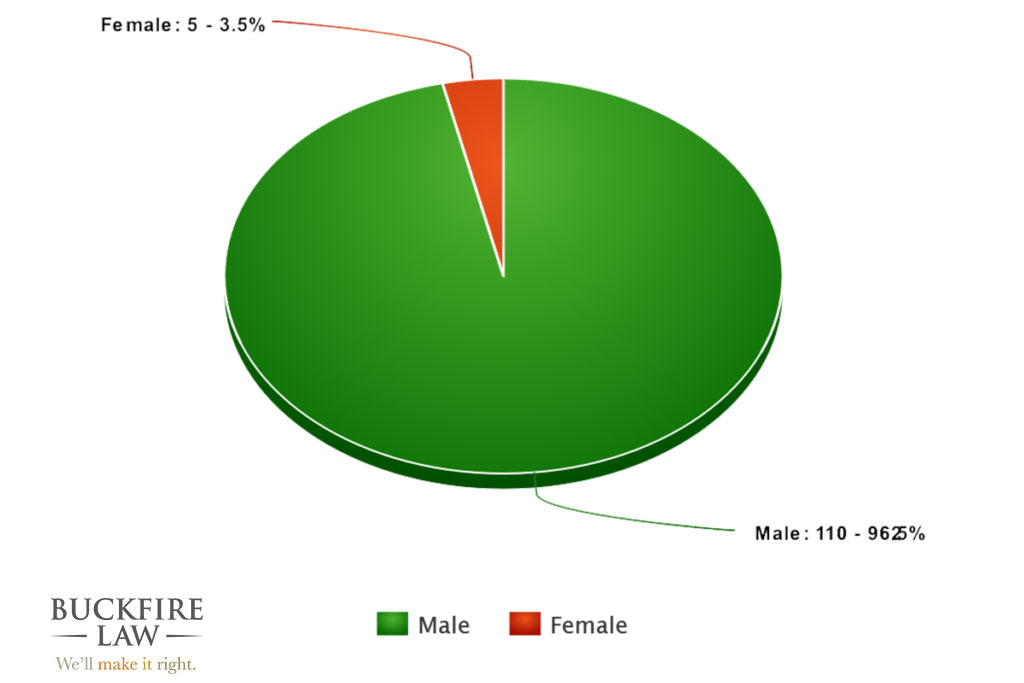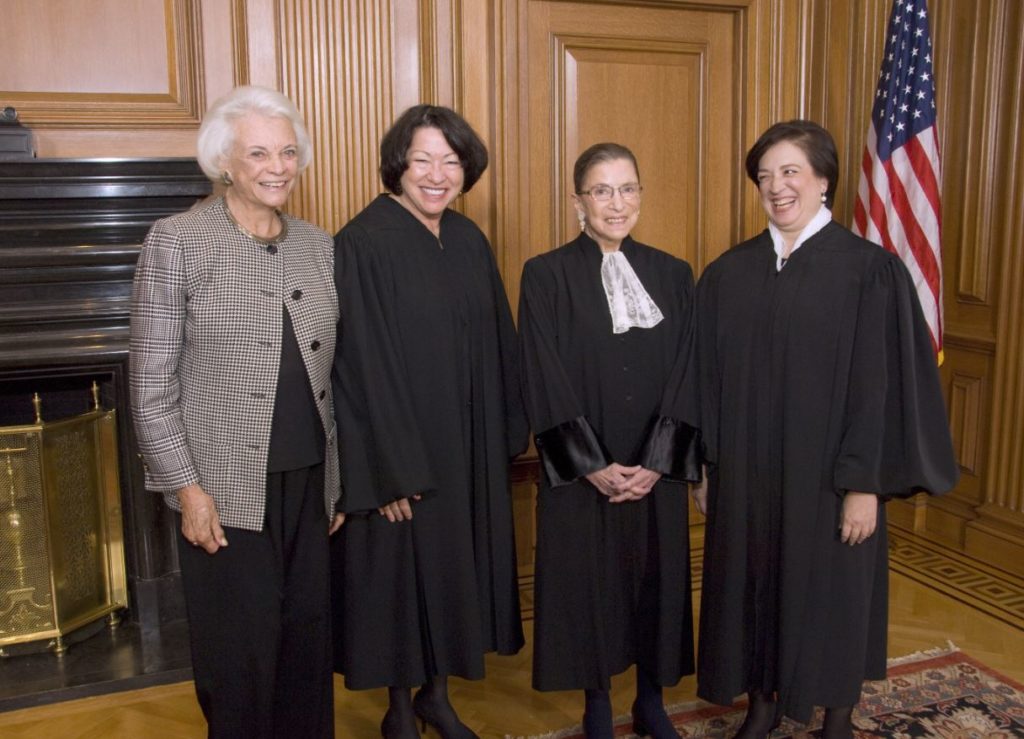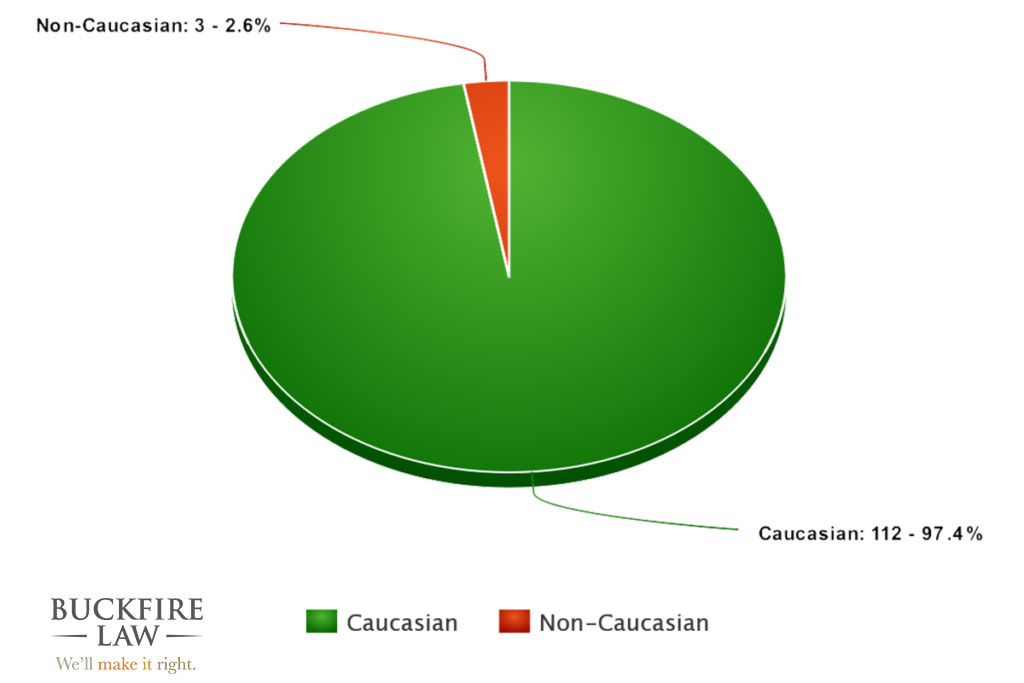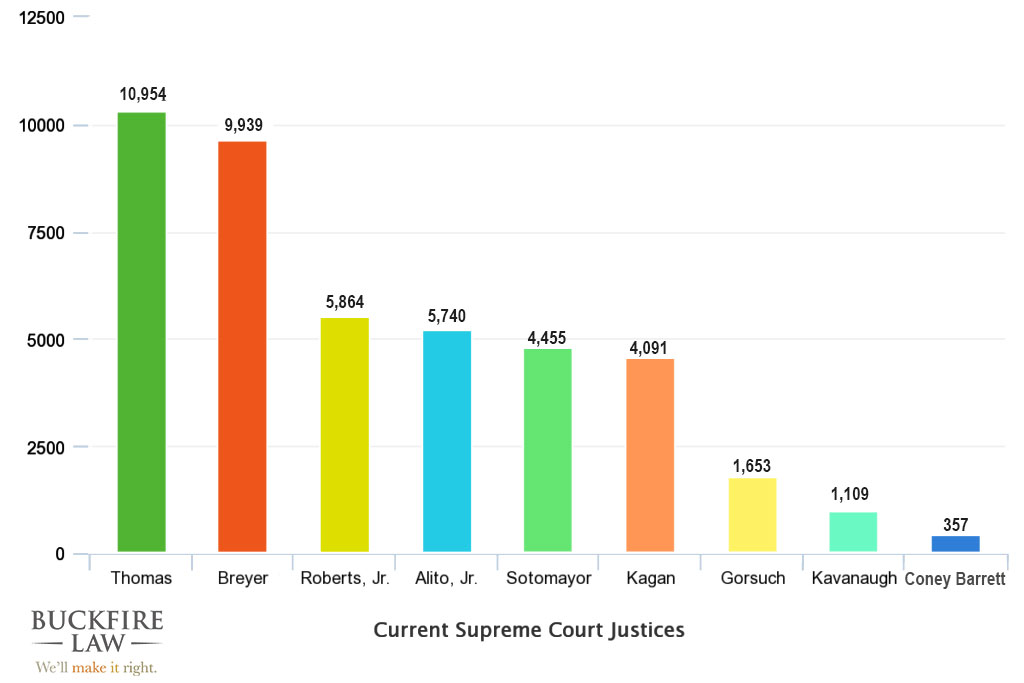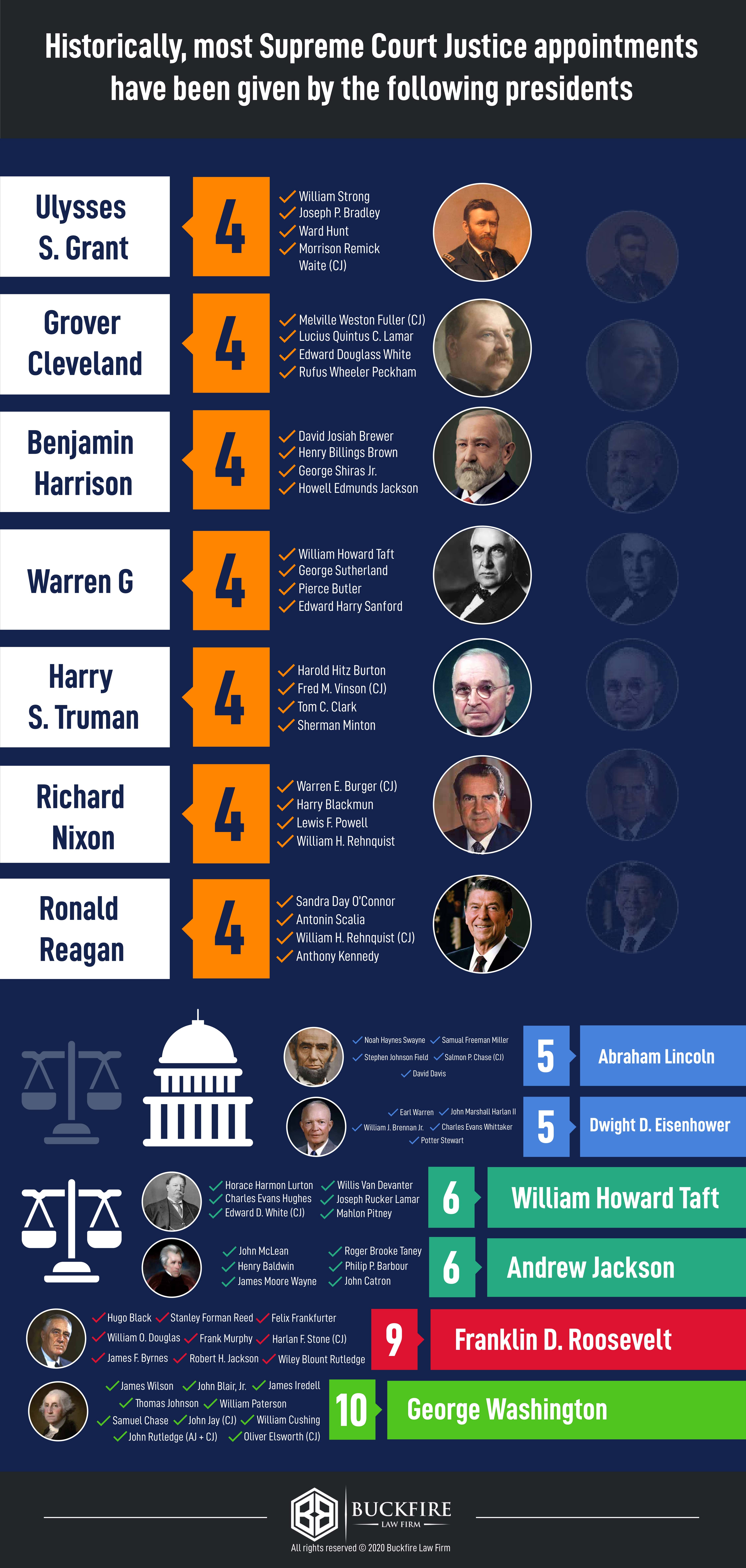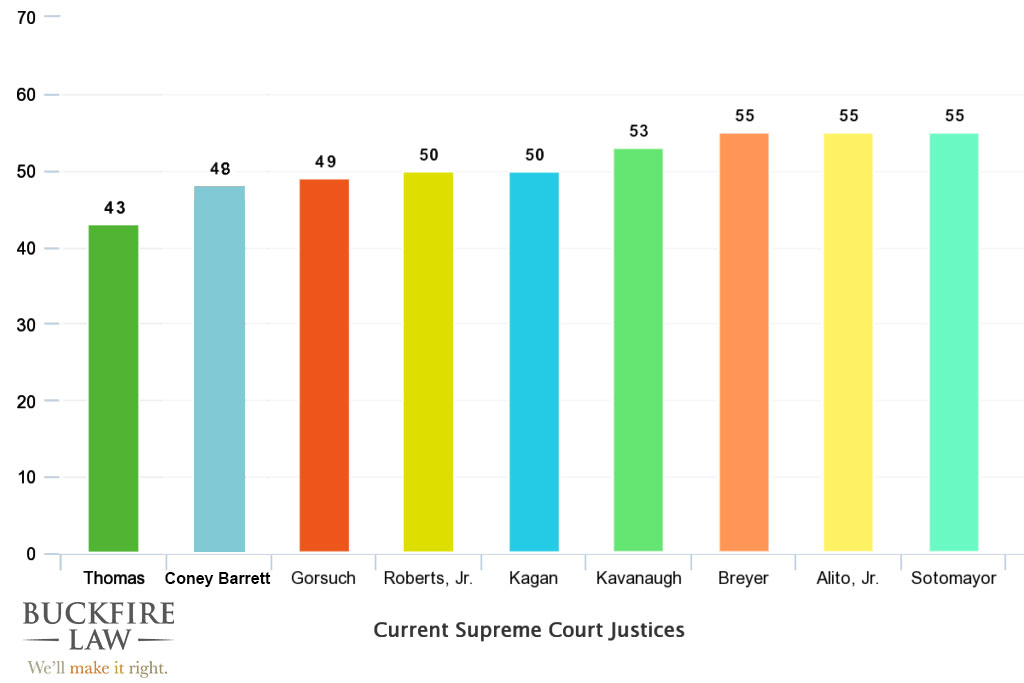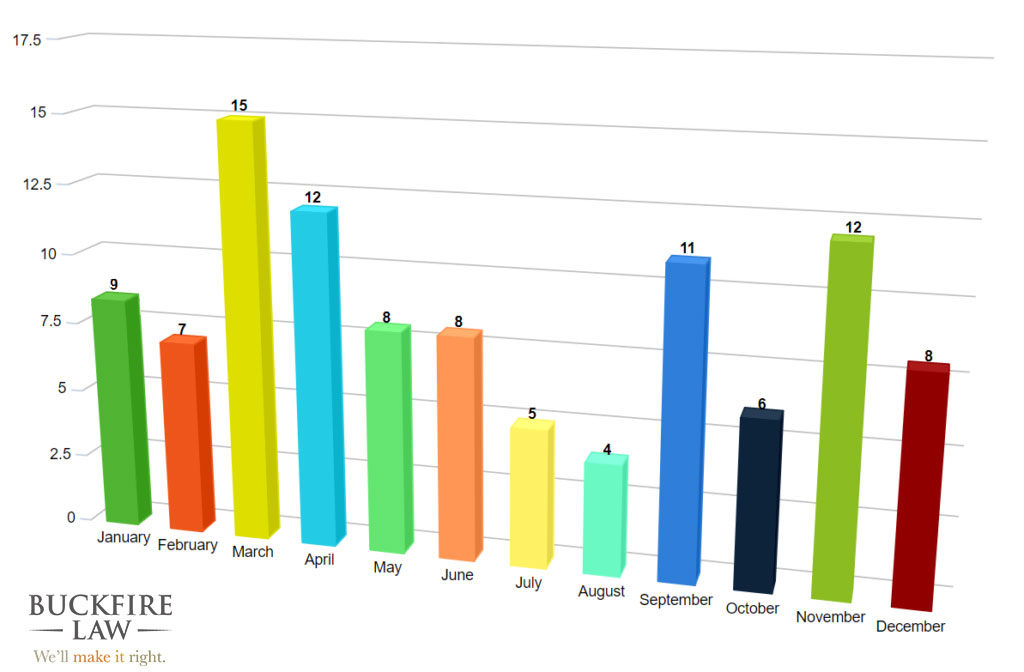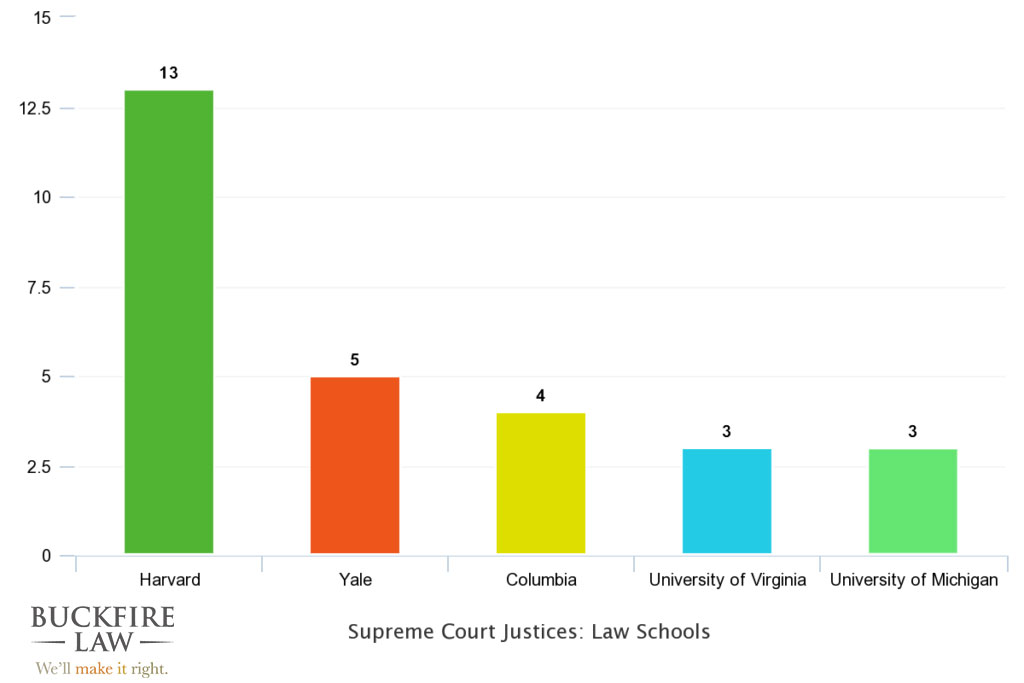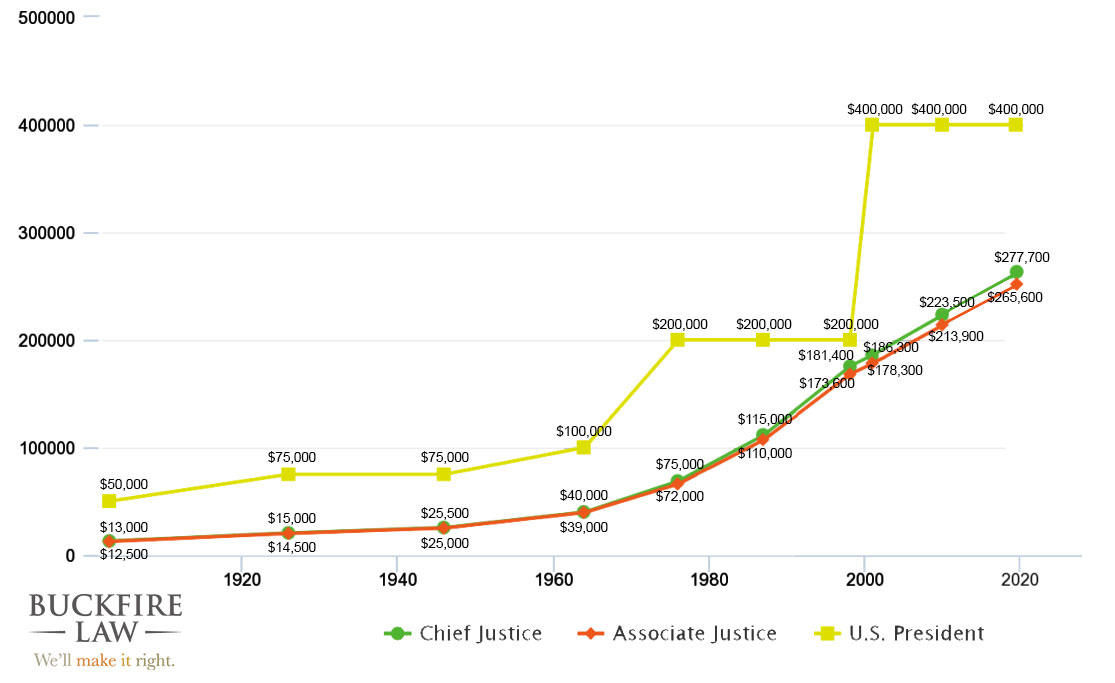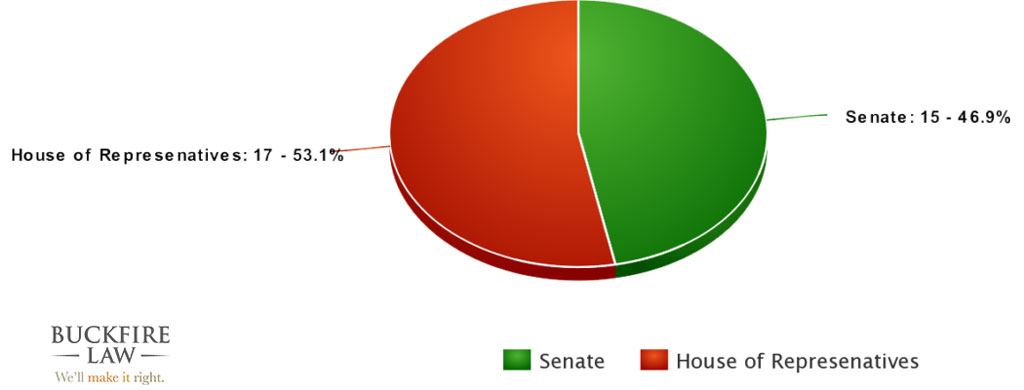The Supreme Court of the United States is the highest-ranking judicial body in the country and is recognized as the court of last resort in the United States. Currently, there are nine United States Supreme Court Justices on the highest court in the land.
The following student guide provides background information, including demographics, and speaks to the history of the Court and the Justices of the Court.
- Justices by State
- Justices by Gender
- Justices by Race/Ethnicity
- Justices by Longest Terms
- Justices Appointed by Presidents
- Justices by Religion
- Justices: Age of Appointment
- Justices: Universities Attended
- Justices: Historical Salaries
- Justices: Appointments By Decade
What Types of Cases go to the U.S. Supreme Court?
The Supreme Court chooses which cases that it wants to hear and decide. The types of cases range vary from a variety of constitutional law matters to cases considered to be of high public importance. This includes cases regarding taxation, immigration, freedom of speech, defective products, personal injury, and criminal matters.
Many cases involve employment law issues and matters involving discrimination. This includes discrimination based upon race, religion, and sexual orientation.
Cases in which the United States is a party often go to the Supreme Court. The same is for cases between different states or cases involving ambassadors.
How does Someone become a Supreme Court Justice?
There are a total of nine judges on the U.S. Supreme Court. When a position becomes open due to the death or resignation of a sitting judge, the President can appoint a person to the position. This is often a highly contested appointment because these judges can shape the law for the land for a very long time.
Most of these appointments are political in nature, meaning the President chooses to appoint someone who will make decisions based upon political and ideological beliefs. As such, the bench is not always considered impartial, or fair, because there is often a political agenda behind a court ruling.
After an appointment is made by the President, there are hearings in the Senate to approve the candidate for the position. If, after the hearing, the Senate confirms the appointment the new justice is sworn into office. It is a lifetime appointment and therefore very important to the separation of powers of our government.
U.S. Supreme Court Justice Background Information
The Constitution states that the Supreme Court has both original and appellate jurisdiction. Original jurisdiction means that the Supreme Court is the first, and only, Court to hear a case.
The Constitution limits original jurisdiction cases to those involving disputes between the states or disputes arising among ambassadors and other high-ranking ministers.
Appellate jurisdiction means that the Court has the authority to review the decisions of lower courts. Most of the cases the Supreme Court hears are appeals from lower courts.
Many cases that the Court reviews concern the U.S. Constitution, and the Court’s decisions have far-reaching implications for the citizenry and the history of the United States.
Few other courts in the world have the same authority of constitutional interpretation and none have exercised it for as long or with as much influence.
What is the Total Number of Supreme Court Judges?
- The Supreme Court has nine (9) Justices: one (1) Chief Justice and eight (8) Associate Justices.
- There have been a total of 116 Justices as of July 2022.
- In total, there have been 17 Chief Justices and 103 Associate Justices
- Five (5) judges have served as both chief and associate justice: John Rutledge, Edward Douglass White, Charles Evans Hughes, Harlan Fiske Stone, William H. Rehnquist.
Which States Provide the Most Supreme Court Justices?
Historically, Supreme Court Justices have come from the following states:
| Alabama: 3 | Arizona: 2 | California: 4 |
| Colorado: 2 | Connecticut: 3 | Georgia: 4 |
| Iowa: 2 | Illinois: 4 | Indiana: 1 |
| Kentucky: 5 | Louisiana: 2 | Massachusetts: 10 |
| Maryland: 6 | Maine: 1 | Michigan: 2 |
| Minnesota: 2 | Massachusetts: 1 | Mississippi: 1 |
| North Carolina: 2 | New Hampshire: 2 | New Jersey: 5 |
| New York: 15 | Ohio: 9 | Pennsylvania: 6 |
| South Carolina: 3 | Tennessee: 6 | Texas: 1 |
| Utah: 1 | Virginia: 9 | Wyoming: 1 |
How many Women have been Supreme Court Justices?
Total Number of Men vs. Total Number of Women
*No woman has served as a U.S. Supreme Court Chief Justice
First Woman: Sandra Day O’Connor (1981-2006)
Only six women have served as Justices on the Supreme Court of the United States (SCOTUS). Justice O’Connor made history when she became the first woman to serve the Court in 1981.
- Ruth Bader Ginsberg
- Elena Kagan
- Sandra Day O’Connor
- Sonia Sotomayor
- Amy Coney Barrett
- Ketanji Brown Jackson
Supreme Court Justices by Race/Ethnicity
As of September 2022, there are currently:
- Six (6) Caucasian Supreme Court Justices and three (3) non-Caucasian Supreme Court Justices.
- Ketanji Brown Jackson is the first female African American Justice and the first former federal public defender to serve.
- Sonia Sotomayor is the first and only Hispanic Supreme Court Justice.
- Eight percent of the Supreme Court Justices are Caucasian — 22.2% are non-Caucasian.
Historically:
- 112 Caucasian Supreme Court Justices and three (3) non-Caucasian Supreme Court Justices.
- Three (3) African American Justices: Thurgood Marshall, Clarence Thomas, and Kentanji Brown Jackson.
- 99% of Supreme Court Justices have been Caucasian.
Were any Judges Born Outside of the United States?
All current Supreme Court Justices have been born in the United States. Historically, six (6) Justices were born outside of the U.S.:
- James Wilson (1789-1798), born in Caskardy, Scotland
- James Iredell (1790-1799), born in Lewes, England
- William Paterson (1793-1806), born in County Antrim, Ireland
- David J. Brewer (1889-1910), born in Smyrna, Turkey
- George Sutherland (1922-1939), born in Buckinghamshire, England
- Felix Frankfurter (1939-1962), born in Vienna, Austria
What is the Longest Term for a Supreme Court Justice?
Longest terms among current Supreme Court Justices (as of Oct. 19, 2021):
Longest terms served among all Supreme Court Justices (as of Dec. 31, 2019):
| Supreme Court Justice | Total Days Served |
| William O.Douglas* | 13,358 |
| Stephen Johnson Field | 12,614 |
| John Paul Stevens | 12,611 |
| John Marshall** | 12,570 |
| Hugo Black | 12,447 |
| John Marshall Harlan | 12,360 |
| William J. Brennan, Jr. | 12,330 |
| William Rehnquist | 12,293 |
| Joseph Story | 12,273 |
| James Moore Wayne | 11,860 |
*William O. Douglas is the longest-serving associate justice.
**John Marshall is the longest-serving chief justice.
Shortest terms served among all Supreme Court Justices (excluding current Supreme Court Justices):
| Supreme Court Justice | Total Days Served |
| James F. Byrnes | 452 |
| Thomas Johnson* | 478 |
| John Rutledge | 521 |
| Robert Trimble | 801 |
| Howell Edmunds Jackson | 887 |
| Arthur Goldberg | 1,028 |
| Abe Fortas | 1,318 |
| Alfred Moore | 1,375 |
| William Henry Moody | 1,434 |
*Thomas Johnson is oftentimes considered the shortest-serving judge, but under a temporary recess appointment, he served one month and three days more than Justice Byrnes.
Average terms served among all Supreme Court Justices (as of Dec. 31, 2019):
Historically:
- Supreme Court Justices have served an average term of 16 years.
- Prior to 1970, Supreme Court Justices served an average term of 14.9 years.
- Post 1970, Supreme Court Justices have served an average term of 26.1 years.
Currently:
- The five (5) most recently appointed Supreme Court Justices to leave the court have served an average of 27.5 years.
Which President Appointed the Most Judges?
Current Supreme Court Justices have been appointed by the following presidents (in order of most appointments):
The most Supreme Court Justice appointments have been given by the following presidents:
- George Washington, 10
- John Jay (CJ)
- John Rutledge (AJ + CJ)
- William Cushing
- James Wilson
- John Blair, Jr.
- James Iredell
- Thomas Johnson
- William Paterson
- Samuel Chase
- Oliver Elsworth (CJ)
- Franklin D. Roosevelt, 9
- Hugo Black
- Stanley Forman Reed
- Felix Frankfurter
- William O. Douglas
- Frank Murphy
- Harlan F. Stone (CJ)
- James F. Byrnes
- Robert H. Jackson
- Wiley Blount Rutledge
- Andrew Jackson, 6
- John McLean
- Henry Baldwin
- James Moore Wayne
- Roger Brooke Taney
- Philip P. Barbour
- John Catron
- William Howard Taft, 6
- Horace Harmon Lurton
- Charles Evans Hughes
- Edward D. White (CJ)
- Willis Van Devanter
- Joseph Rucker Lamar
- Mahlon Pitney
- Abraham Lincoln, 5
- Noah Haynes Swayne
- Samual Freeman Miller
- David Davis
- Stephen Johnson Field
- Salmon P. Chase (CJ)
- Dwight D. Eisenhower, 5
- Earl Warren (CJ)
- John Marshall Harlan II
- William J. Brennan Jr.
- Charles Evans Whittaker
- Potter Stewart
The following presidents did not appoint any Supreme Court Justices during their presidency:
- William Henry Harrison
- Zachary Taylor
- Andrew Johnson
What Religions are the Supreme Court Judges?
Currently, there are:
- Six (6) Catholic Supreme Court Justices
- One (1) Jewish Supreme Court Justice
- One (1) Episcopalian Supreme Court Justice
- One (1) non-denominational Protestant Justice
Historically, there have been:
- 33 Episcopalian Supreme Court Justices
- 19 Presbyterian Supreme Court Justices.
- 17 Supreme Court Justices have unclear religious denominations.
- 13 Protestant Supreme Court Justices.
- 14 Catholic Supreme Court Justices.
- 9 Unitarian Supreme Court Justices.
- 8 Jewish Supreme Court Justices.
- 1 Supreme Court Justice has no religious affiliation.
*Of the 17 Supreme Court Chief Justices: 14 have been Protestant, three have been Catholic.
Supreme Court Justices’ Age at Appointment
Current Supreme Court Justices’ ages at appointment:
Historically, the 10 oldest Supreme Court Justices to be appointed are:
| Supreme Court Justice | Age at Appointment |
| Harlan Fiske Stone | 68 |
| Charles Evans Hughes | 67 |
| Horace Harmon Lurton | 65 |
| Edward Douglass White | 65 |
| Lewis F. Powell, Jr. | 64 |
| William Cushing | 63 |
| William Howard Taft | 63 |
| Ward Hunt | 62 |
| Samuel Blatchford | 62 |
| Lucius Quintus Cincinnatus Lamar II | 62 |
The average age of a Supreme Court Justice at the time of appointment is 53 years.
Historically, the 10 youngest Supreme Court Justices to be appointed are:
| Supreme Court Justice | Age at Appointment |
| William Johnson | 32 |
| Joseph Story | 32 |
| Bushrod Washington | 36 |
| James Iredell | 38 |
| William O. Douglas | 40 |
| John A. Campbell | 41 |
| Thomas Todd | 42 |
| Benjamin R. Curtis | 42 |
| John Jay | 43 |
| John McLean | 43 |
Supreme Court Justices’ Age at Retirement
In total, 40 Supreme Court Justices have retired.
The 10 oldest Supreme Court Justices at retirement are as follows:
| Supreme Court Justice | Age at Retirement |
| Oliver Wendell Holmes, Jr. | 90 |
| John Paul Stevens | 90 |
| Henry Blackmun | 86 |
| Hugo Lafayette Black | 85 |
| William Joseph Brennan, Jr. | 84 |
| Stephen Breyer | 84 |
| Thurgood Marshall | 83 |
| Louis Dembitz Brandeis | 82 |
| Joseph McKenna | 82 |
| Anthony McLeod Kennedy | 82 |
The average age for a Supreme Court Justice at the time of retirement is 69 years old.
The 10 youngest Supreme Court Justices at retirement are as follows:
| Supreme Court Justice | Age at Retirement |
| William Henry Moody | 57 |
| Charles Evans Whittaker | 61 |
| John Hessin Clarke | 65 |
| Sherman Minton | 66 |
| Potter Stewart | 66 |
| Tom C. Clark | 68 |
| Henry Billings Brown | 70 |
| Harold Hitz Burton | 70 |
| David Souter | 70 |
| George Shiras, Jr. | 71 |
Supreme Court Justices’ Age at Resignation
In total, 17 Supreme Court Justices have resigned. The 10 youngest to resign are as follows:
| Supreme Court Justice | Age at Retirement |
| Benjamin Robbins Curtis | 47 |
| Alfred Moore | 48 |
| John Jay | 49 |
| John Archibald Campbell | 49 |
| John Rutledge* | 52 |
| Charles Evans Hughes** | 54 |
| Oliver Ellsworth | 55 |
| John Rutledge | 55 |
| Arthur Goldberg | 57 |
| Abe Fortas | 59 |
*John Rutledge resigned as an Associate Justice at age 52, and resigned as a Chief Justice at age 55.
*Charles Evans Huges resigned as an Associate Justice at age 54, and retired as a Chief Justice at age 79.
What are the Birth Months of the Supreme Court Justices?
Historically, Supreme Court Justices have been born in the following months:
What Universities Produced the Most Supreme Court Judges?
The current members of the Supreme Court have graduated from the following universities:
| Supreme Court Justice | Undergrad | Law School |
| Brett Kavanaugh | Yale | Yale |
| Neil Gorsuch | Columbia | Harvard |
| Elena Kagan | Princeton | Harvard |
| Sonia Sotomayor | Princeton | Yale |
| Samuel Alito | Princeton | Yale |
| John Roberts | Harvard | Harvard |
| Kentanji Brown Jackson | Harvard | Harvard |
| Amy Coney Barret | Rhodes College | Notre Dame |
| Clarence Thomas | Holy Cross | Yale |
Historically, the five law schools where the most Supreme Court Justices have attended are as follows:
Supreme Court Justices: Lawyers vs. Non-Lawyers
- Each of the current Supreme Court Justices were lawyers.
- Historically, only two Supreme Court Justices have not been lawyers
- James F. Byrnes (left)
- Robert H. Jackson (right)
What Political Party has the most Supreme Court Justices?
- There are currently three (3) Supreme Court Justices who are Democrats.
- There are currently six (6) Supreme Court Justices who are Republicans.
Historically, Supreme Court Justices have been affiliated with the following political party:
How much Money Does a Supreme Court Judge Get Paid?
The line chart below details the salaries of Supreme Court Associate Justices, the Chief Justice and the U.S. President during a given year:
| Year | Chief Justice | Associate Justices | President |
| 1903 | $13,000 | $12,500 | $50,000 |
| 1911 | $15,000 | $14,500 | $75,000 |
| 1926 | $20,500 | $20,000 | $75,000 |
| 1946 | $25,500 | $25,000 | $75,000 |
| 1955 | $35,500 | $35,000 | $100,000 |
| 1964 | $40,000 | $39,500 | $100,000 |
| 1969 | $62,500 | $60,000 | $200,000 |
| 1975 | $65,600 | $63,000 | $200,000 |
| 1976 | $68,800 | $66,000 | $200,000 |
| 1977 | $75,000 | $72,000 | $200,000 |
| 1978 | $79,100 | $76,000 | $200,000 |
| 1979 | $84,700 | $81,300 | $200,000 |
| 1980 | $92,400 | $88,700 | $200,000 |
| 1981 | $96,800 | $93,000 | $200,000 |
| 1982 | $100,700 | $96,700 | $200,000 |
| 1984 | $104,700 | $100,600 | $200,000 |
| 1985 | $108,400 | $104,100 | $200,000 |
| 1987 | $111,700 | $107,200 | $200,000 |
| 1987 | $115,000 | $110,000 | $200,000 |
| 1990 | $124,000 | $118,600 | $200,000 |
| 1991 | $160,600 | $153,600 | $200,000 |
| 1992 | $166,200 | $159,000 | $200,000 |
| 1993 | $171,500 | $164,100 | $200,000 |
| 1998 | $175,400 | $167,900 | $200,000 |
| 2000 | $181,400 | $173,600 | $200,000 |
| 2001 | $186,300 | $178,300 | $400,000 |
| 2002 | $192,600 | $184,400 | $400,000 |
| 2003 | $198,600 | $190,100 | $400,000 |
| 2004 | $203,000 | $194,300 | $400,000 |
| 2005 | $208,100 | $199,200 | $400,000 |
| 2006 | $212,100 | $203,000 | $400,000 |
| 2008 | $217,400 | $208,100 | $400,000 |
| 2009 | $223,500 | $213,900 | $400,000 |
| 2010 | $223,500 | $213,900 | $400,000 |
| 2011 | $223,500 | $213,900 | $400,000 |
| 2012 | $223,500 | $213,900 | $400,000 |
| 2013 | $223,500 | $213,900 | $400,000 |
| 2014 | $255,500 | $244,400 | $400,000 |
| 2015 | $258,100 | $246,800 | $400,000 |
| 2016 | $260,700 | $249,300 | $400,000 |
| 2017 | $263,300 | $251,800 | $400,000 |
| 2018 | $267,000 | $255,300 | $400,000 |
| 2019 | $270,700 | $258,900 | $400,000 |
| 2020 | $277,700 | $265,600 | $400,000 |
| 2021 | $280,500 | $268,300 | $400,000 |
Have any Supreme Court Justices been Impeached?
Only one (1) Supreme Court Justice has been impeached. Samuel Chase was impeached in 1804. The U.S. House of Representatives voted to impeach him claiming he acted in a partisan manner in deciding several trials. Essentially, the claim was that he was not acting as an independent and impartial judge.
However, in 1805 Chase was acquitted by the Senate. This decision helped safeguard the independence of the judiciary. He served on the court until his death in 1811.
Which Supreme Court Justices Died in Office?
In total, 50 Supreme Court Justices have died in office. The list below outlines the justices below who have died in office, based on when each Justice entered office:
- William Cushing – 1810
- James Wilson – 1798
- James Iredell – 1799
- William Paterson- 1806
- Samuel Chase- 1811
- Bushrod Washington- 1829
- John Marshall- 1835
- William Johnson – 1834
- Henry Brockholst Livingston- 1823
- Thomas Todd – 1826
- Joseph Story – 1845
- Smith Thompson – 1843
- Robert Trimble – 1828
- John McLean – 1861
- Henry Baldwin – 1844
- James Moore Wayne – 1867
- Roger B. Taney – 1864
- Philip Pendleton Barbour – 1841
- John Catron – 1865
- John McKinley – 1852
- Peter Vivian Daniel – 1860
- Levi Woodbury – 1851
- Nathan Clifford – 1881
- Samuel Freeman Miller – 1890
- Salmon P. Chase- 1873
- Joseph P. Bradley – 1892
- Morrison Waite – 1888
- John Marshall Harlan – 1911
- William Burnham Woods – 1887
- Stanley Matthews – 1889
- Horace Gray – 1902
- Samuel Blatchford – 1893
- Lucius Quintus Cincinnatus Lamar – 1893
- Melville Fuller- 1910
- David Josiah Brewer- 1910
- Howell Edmunds Jackson- 1895
- Rufus W. Peckham- 1909
- Horace Harmon Lurton – 1914
- Edward Douglass White – 1921
- Joseph Rucker Lamar – 1916
- Pierce Butler – 1939
- Edward Terry Stanford – 1930
- Benjamin N. Cardozo – 1938
- Frank Murphy – 1949
- Harlan F. Stone- 1946
- Robert H. Jackson – 1954
- Wiley Blount Rutledge – 1949
- Fred M. Vinson – 1953
- William Rehnquist – 2005
- Antonin Scalia- 2016
- Ruth Bader Ginsburg- 2020
What are the most Common Names?
The top five most common names among Supreme Court Justices are as follows:
- John (13)
- John Jay
- John Rutledge
- John Marshall
- John G. Roberts Jr.
- John Blair
- John McLean
- John Catron
- John McKinley
- John Archibald Campbell
- John Marshall Harlan
- John Hessin Clarke
- John Marshall Harlan
- John Paul Stevens
- William (11)
- William Howard Taft
- William H. Rehnquist
- William Cushing
- William Paterson
- William Johnson
- William Strong
- William Burnham Woods
- William Rufus Day
- William Henry Moody
- William Orville Douglas
- William J. Brennan Jr.
- James (5)
- James Wilson
- James Iredell
- James Moore Wayne
- James Clark McReynolds
- James Francis Byrnes
- Samuel (5)
- Samuel Chase
- Samuel Nelson
- Samuel Freeman Miller
- Samuel Blatchford
- Samuel A. Alito Jr.
- Joseph (4)
- Joseph Story
- Joseph P. Bradley
- Joseph McKenna
- Joseph Rucker Lamar
Supreme Court Justices Appointments By Decade
In the 1780s, 5 Justices were appointed:
- Blair, John, Jr.
- Cushing, William
- Jay, John
- Rutledge, John
- Wilson, James
In the 1790s, 7 Justices were appointed:
- Iredell, James
- Johnson, Thomas
- Paterson, William
- Chase, Samuel
- Ellsworth, Oliver
- Washington, Bushrod
- Moore, Alfred
In the 1800s, 4 Justices were appointed:
- Marshall, John
- Johnson, William
- Livingston, Henry Brockholst
- Todd, Thomas
In the 1810s, 2 Justices were appointed:
- Duvall, Gabriel
- Story, Joseph
In the 1820s, 3 Justices were appointed:
- Thompson, Smith
- Trimble, Robert
- McLean, John
In the 1830s, 6 Justices were appointed:
- Baldwin, Henry
- Barbour, Philip Pendelton
- Taney, Roger Brooke
- Wayne, James Moore
- Catron, John
- McKinley, John
In the 1840s, 4 Justices were appointed:
- Daniel, Peter Vivian
- Nelson, Samuel
- Woodbury, Levi
- Grier, Robert Cooper
In the 1850s, 3 Justices were appointed:
- Curtis, Benjamin Robbins
- Campbell, John Archibald
- Clifford, Nathan
In the 1860s, 5 Justices were appointed:
- Davis, David
- Miller, Samuel Freeman
- Swayne, Noah Haynes
- Field, Stephen Johnson
- Chase, Salmon Portland
In the 1870s, 5 Justices were appointed:
- Bradley, Joseph P.
- Strong, William
- Hunt, Ward
- Waite, Morrison Remick
- Harlan, John Marshall (I)
In the 1880s, 7 Justices were appointed:
- Woods, William Burnham
- Gray, Horace
- Matthews, Stanley
- Blatchford, Samuel
- Lamar, Lucius Quintus Cincinnatus
- Fuller, Melville Weston
- Brewer, David Josiah
In the 1890s, 6 Justices were appointed:
- Brown, Henry Billings
- Shiras, George, Jr.
- Jackson, Howell Edmunds
- White, Edward Douglass
- Peckham, Rufus Wheeler
- McKenna, Joseph
In the 1900s, 4 Justices were appointed:
- Holmes, Oliver Wendell, Jr
- Day, William Rufus
- Moody, William Henry
- Lurton, Horace Harmon
In the 1910s, 7 Justices were appointed:
- Hughes, Charles Evans
- Lamar, Joseph Rucker
- Van Devanter, Willis
- Pitney, Mahlon
- McReynolds, James Clark
- Brandeis, Louis Dembitz
- Clarke, John Hessin
In the 1920s, 5 Justices were appointed:
- Taft, William Howard
- Butler, Pierce
- Sutherland, George
- Sanford, Edward Terry
- Stone, Harlan Fiske
In the 1930s, 6 Justices were appointed:
- Roberts, Owen Josephus
- Cardozo, Benjamin Nathan
- Black, Hugo Lafayette
- Reed, Stanley Forman
- Douglas, William Orville
- Frankfurter, Felix
In the 1940s, 8 Justices were appointed:
- Murphy, Francis (Frank) William
- Byrnes, James Frances
- Jackson, Robert Houghwout
- Rutledge, Wiley Blount
- Burton, Harold Hitz
- Vinson, Fred Moore
- Clark, Tom Campbell
- Minton, Sherman
In the 1950s, 5 Justices were appointed:
- Warren, Earl
- Harlan, John Marshall (II)
- Brennan, William Joseph, Jr.
- Whittaker, Charles Evans
- Stewart, Potter
In the 1960s, 5 Justices were appointed:
- Goldberg, Arthur Joseph
- White, Byron Raymond
- Fortas, Abe
- Marshall, Thurgood
- Burger, Warren Earl
In the 1970s, 4 Justices were appointed:
- Blackmun, Harry Andrew
- Powell, Lewis Franklin, Jr.
- Rehnquist, William Hubbs
- Stevens, John Paul
In the 1980s, 3 Justices were appointed:
- O’Connor, Sandra Day
- Scalia, Antonin
- Kennedy, Anthony McLeod
In the 1990s, 4 Justices were appointed:
- Souter, David H.
- Thomas, Clarence
- Ginsburg, Ruth Bader
- Breyer, Stephen G.
In the 2000s, 3 Justices were appointed:
- Alito, Samuel A., Jr.
- Roberts, John G., Jr.
- Sotomayor, Sonia Maria
In the 2010s, 3 Justices were appointed:
- Kagan, Elena
- Gorsuch, Neil McGill
- Kavanaugh, Brett Michael
So far in the 2020s, 2 Justice has been appointed:
- Barret, Amy Coney
- Jackson, Kentanji Brown
Have any Supreme Court Justices Served in Congress?
In total, 28 Supreme Court Justices have served in Congress, including:
- 15 Justices have served in the Senate.
- Hugo Black
- Harold Hitz Burton
- James. F. Byrnes
- Oliver Ellsworth
- Edward Douglass White
- Levi Woodbury
- David Davis
- Howell Edmunds Jackson
- Lucius Quintus Cincinnatus Lamar
- Salmon P. Chase
- Stanley Matthews
- John McKinley
- Sherman Minton
- George Sutherland
- William Paterson
- 17 Justices have served in the House of Representatives.
- Henry Baldwin
- Philip Pendleton Barbour
- James. F. Byrnes
- Nathan Clifford
- Gabriel Duvall
- Lucius Quintus Cincinnatus Lamar
- John Marshall
- Joseph McKenna
- John McKinley
- John McLean
- William Henry Moody
- Mahlon Pitney
- Joseph Story
- William Strong
- George Sutherland
- Fred M. Vinson
- James Moore Wayne
Important Supreme Court Justice Resources
- Supreme Court of the United States – FAQs
- Supreme Court of the United States – About the Court
- Supreme Court Justice History – CNN
- Supreme Court of the United States – Blog
- Why Supreme Court Justices Serve Such Long Terms – The Economist
- More Than 2 Centuries of Supreme Court Justices, in 18 Numbers – PBS
- Washington University in St. Louis – Lee Epstein
- Salary History for the President of the United States – Presidents USA
(Main)
- 29000 Inkster Road
Suite 150
Southfield, MI 48034
- Phone: (248) 595-7544
- 19 Clifford St.
Suite 805 Merchants Row
Detroit, MI 48226
- Phone: (313) 992-8281
(Woodward Address)
- 1001 Woodward Ave.
Suite 505
Detroit, MI 48226
- Phone: (313) 777-8482
- 343 S. Main Street
#206
Ann Arbor, MI 48104
- Phone: (734) 888-3003
- 51424 Van Dyke Ave
#3
Shelby Township, MI 48316
- Phone: (586) 250-2626
- 432 N. Saginaw Street
Suite 413
Flint, MI 48502
- Phone: (810) 818-8182

